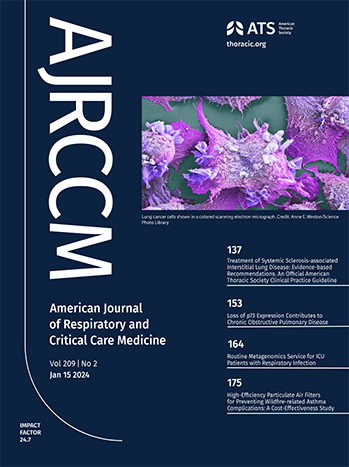调节性T细胞中p300依赖性调节在过敏性哮喘中起关键作用。
IF 19.4
1区 医学
Q1 CRITICAL CARE MEDICINE
American journal of respiratory and critical care medicine
Pub Date : 2025-10-06
DOI:10.1164/rccm.202407-1410oc
引用次数: 0
摘要
哮喘是一种慢性炎性气道疾病,受表观遗传修饰影响。E1A结合蛋白p300 (p300)是调节多种基因转录的关键组蛋白乙酰转移酶。目的探讨p300在变应性哮喘患者免疫应答调节中的作用。方法建立系统性p300缺失和调节性T细胞(Treg)特异性p300缺失小鼠的过敏性哮喘模型。在哮喘小鼠和哮喘患者活检样本中评估组蛋白乙酰转移酶活性和p300表达。接下来,研究辅助性T - 2细胞和Tregs的免疫应答。此外,利用分类的treg进行染色质免疫沉淀和rna测序。通过体外抑制和过表达实验证实鸟苷酸结合蛋白5 (GBP5)在Tregs中的功能研究。哮喘小鼠的乙酰转移酶活性和p300水平升高。哮喘患者的P300表达也高于对照组。p300全身性缺失小鼠的2型免疫应答升高,Treg数量和功能下降。此外,p300缺失降低了Tregs的抑制能力和分化潜力。treg特异性p300缺失小鼠的过敏性炎症也加重。染色质免疫沉淀和rna测序显示GBP5是Tregs中p300的主要靶基因。GBP5过表达可改善p300缺失引起的Treg增殖减少。结论sp300通过增强Treg功能,部分通过gbp5介导的调节,从而抑制th2驱动的气道炎症,对变应性哮喘具有保护作用。本文章由计算机程序翻译,如有差异,请以英文原文为准。
p300-Dependent Modulation in Regulatory T Cells Plays a Crucial Role in Allergic Asthma.
RATIONALE
Asthma is a chronic inflammatory airway disease, affected by epigenetic modifications. E1A binding protein p300 (p300) is a pivotal histone acetyltransferase that regulates the transcription of diverse genes.
OBJECTIVES
We investigated the role of p300 in regulating immune responses during allergic asthma.
METHODS
An allergen-induced asthma model was established in mice with systemic p300 deletion and regulatory T cell (Treg)-specific p300 deletion. Histone acetyltransferase activity and p300 expression were evaluated in asthma-induced mice and biopsy samples from patients with asthma. Next, immune responses of T helper 2 cells and Tregs were investigated. Additionally, chromatin immunoprecipitation- and RNA-sequencing were conducted using the sorted Tregs. Functional studies of guanylate binding protein 5 (GBP5) in Tregs were confirmed through in vitro inhibition and overexpression tests.
MEASUREMENTS AND MAIN RESULTS
Histone acetyltransferase activity and p300 levels were elevated in mice with asthma. p300 expression was also higher in patients with asthma than in control subjects. Mice with systemic p300 deletion had elevated type-2 immune responses and decreased Treg population and functions. Furthermore, p300 deletion reduced the suppression ability and differentiation potential of Tregs. Allergic inflammation was also exacerbated in mice with Treg-specific p300 deletion. Chromatin immunoprecipitation- and RNA-sequencing revealed GBP5 as a primary target gene of p300 in Tregs. GBP5 overexpression ameliorated the reduction in Treg proliferation caused by p300 depletion.
CONCLUSIONS
p300 plays a protective role in allergic asthma by enhancing Treg function, partly through GBP5-mediated regulation, thereby suppressing Th2-driven airway inflammation.
求助全文
通过发布文献求助,成功后即可免费获取论文全文。
去求助
来源期刊
CiteScore
27.30
自引率
4.50%
发文量
1313
审稿时长
3-6 weeks
期刊介绍:
The American Journal of Respiratory and Critical Care Medicine focuses on human biology and disease, as well as animal studies that contribute to the understanding of pathophysiology and treatment of diseases that affect the respiratory system and critically ill patients. Papers that are solely or predominantly based in cell and molecular biology are published in the companion journal, the American Journal of Respiratory Cell and Molecular Biology. The Journal also seeks to publish clinical trials and outstanding review articles on areas of interest in several forms. The State-of-the-Art review is a treatise usually covering a broad field that brings bench research to the bedside. Shorter reviews are published as Critical Care Perspectives or Pulmonary Perspectives. These are generally focused on a more limited area and advance a concerted opinion about care for a specific process. Concise Clinical Reviews provide an evidence-based synthesis of the literature pertaining to topics of fundamental importance to the practice of pulmonary, critical care, and sleep medicine. Images providing advances or unusual contributions to the field are published as Images in Pulmonary, Critical Care, Sleep Medicine and the Sciences.
A recent trend and future direction of the Journal has been to include debates of a topical nature on issues of importance in pulmonary and critical care medicine and to the membership of the American Thoracic Society. Other recent changes have included encompassing works from the field of critical care medicine and the extension of the editorial governing of journal policy to colleagues outside of the United States of America. The focus and direction of the Journal is to establish an international forum for state-of-the-art respiratory and critical care medicine.

 求助内容:
求助内容: 应助结果提醒方式:
应助结果提醒方式:


